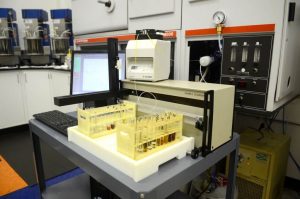Understand Elemental Spectroscopy

ELEMENTAL SPECTROSOCPY
A wealth of information is available on your oil analysis report about wear behavior, contaminants entering the system, and the service needed. Elemental Spectroscopy data can tell a big part of the story.
As you read your oil analysis report, ask yourself what all the data means. Ask yourself other questions like: Where is contaminant debris coming from in this unit? What am I looking for that will help me see what is happening inside my machine? Am I looking at elemental levels that are from the additives, particles being picked up as the oil circulates, or from external contaminant ingression?
These elements — iron, chromium, aluminum, copper, lead, tin, nickel, antimony, silver, titanium, and manganese — commonly indicate component wear. On your oil analysis report, some elements are singled out such as copper or iron, and given special attention. Elements found in your oil sample are measured in parts per million (ppm), a very small amount. A single ppm is equivalent to 0.0001 percent. To put that in perspective, it takes 10,000 ppm to equate to 1.0 percent. Concentrations seen in oil analysis reports will be from one to several thousand ppm.





